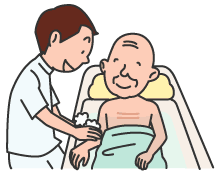 |
| Contents
of insurance services |
 |
 |
 |
| |
 |
|
 Benefits for use of long-term care services include long-term care benefits, available for individuals categorized as persons needing long-term care 1 - 5, and preventive-care benefits, available for individuals categorized as persons needing assistance 1 - 2. Benefits for use of long-term care services include long-term care benefits, available for individuals categorized as persons needing long-term care 1 - 5, and preventive-care benefits, available for individuals categorized as persons needing assistance 1 - 2.
Both long-term care benefits and preventive-care benefits cover 70% - 90% of service costs.
Details of the services available for use are described below. |
|
 Details of available
services Details of available
services
|
 |
|
 Services at home Services at home
|
|
Service recipients must pay 10% - 30%
of the costs on their own (they must also pay meal
expenses for outpatient services and accommodation
and meal expenses incurred during short stays).
In addition to home visits, benefits provided include support
for outpatient services, short stays, and related expenses.
|
  Types
of services at home Types
of services at home
|
Visitations
|
Service
recipients receive these services at their
homes.
|
Long-term care on a visitation basis,
Bathing service on a visitation basis,
Nursing on a visitation basis, Rehabilitation
on a visitation basis, Instructions for
medical care at home
|
|
Outpatients
|
Service
recipients receive these services by visiting
care facilities.
|
Long-term care at care facilities, Rehabilitation
at care facilities
|
|
Short stays
|
Service
recipients receive these services during
short-term stays at care facilities.
|
Short stay therapy, Short stay treatment
|
|
Residential
|
Service
recipients receive these services while
residing at facilities that charge for
services, such as homes for the elderly
and care houses.
|
Therapy for persons staying at specified
facilities
|
| Others |
Service
recipients receive these services to help
establish an environment for the provision
of long-term care.
|
Leasing
of welfare appliances, provision of expenses
required for welfare appliances (a maximum
of 100,000 yen per year), Support for home
renovation costs (a maximum of 200,000
yen per house)
|
|
*These preventive-care benefits are referred to as long-term
preventive care benefits.
Example) long-term preventive care on a visitation basis, and
long-term preventive rehabilitation on a visitation basis,
etc. |
|
|
 Services at care facilities Services at care facilities
|
|
Service recipients must pay 10% - 30%
of accomodation and meal expenses.
Services at care facilities may be used by individuals categorized
as persons needing long-term care. Inpatient services are
available at each facility.
|

 Types
of services at care facilities Types
of services at care facilities |
| |
|
Long-term care welfare
facilities for the elderly
(special nursing homes for the elderly)
|
 |
|
Long-term care health
facilities for the elderly (health facilities
for the elderly)
|
 |
|
Long-term care medical
treatment facility (medical treatment beds
for long-term inpatients and beds for those
suffering from acknowledge syndrome)
|
| |
Note: As a general rule, new patients accepted for inpatient care at special nursing homes for the elderly will be restricted to those in the category of persons needing long-term care 3 and above. |
  |
|
|
 Locality-oriented services Locality-oriented services
|
|
Service recipients must pay 10% - 30% of the costs on their own (they must also pay costs of meals for outpatient services and accommodation and meal expenses incurred during inpatient stays).
These services provide flexible support tailored to the actual conditions of each region, allowing people to continue living in the areas they have grown accustomed to. In principle, these services are only available to those who reside in the relevant municipality. |

 Types of locality-oriented services Types of locality-oriented services |
| |
1. Small-scale multifunctional long-term care at home |
 |
2. Group homes for elderly persons with acknowledge syndrome |
 |
3. Daytime services available for dementia patients |
 |
4. Nighttime long-term care on visitation basis |
 |
5. Daily Life Long-Term Care for a Person Admitted to a Community-Based Specified Facility |
 |
6. Admission to a Community-Based Facility for Preventive Daily Long-Term Care of the Elderly Covered by Public Aid |
 |
7. Nursing on a visitation basis of regular rounds and on-demand response |
 |
8. Nursing and small-scale multifunctional domiciliary care services (combination services) |
| |
| *People ranked as needing long-term care 2 may receive 1-3, and those ranked as needing long-term care 1 may receive 1 and 3, as local assistance long-term care preventive services. |
  |
|
long-term preventive care services(preventive-care benefits)
The service menu for these preventive-care benefits includes services for
improving the functioning of locomotive organs, for improving nutrition, and
for improving oral-cavity functions. These benefits are implemented as part of
the existing service program. Examples of the possible use of these services
include muscular training using machinery available at care facilities, as an
outpatient service.
In principle, the preventive-care benefits are managed by comprehensive regional
assistance centers.
Outline of regional assistance services
Regional assistance services
are provided by each municipality to persons who might need assistance
or long-term care. In addition to long-term preventive care services,
these include long-term preventive care management, comprehensive
consultation on regional assistance, services for preventing abuse
and protecting rights, and comprehensive and continuous management.
 Comprehensive regional assistance centers Comprehensive regional assistance centers
The comprehensive regional assistance centers play
a major role in the provision of regional support services. Each
comprehensive regional assistance center serves as an organizational
hub, providing comprehensive assistance and support for the purposes
of maintaining the mental and physical well-being of elderly people
in the region, improving healthcare, welfare, and medical services,
and ensuring a stable lifestyle. Each center is capable of handling
these matters in a coordinated manner, from consultation through
adjustment of services received.
 |
 |
|
 |
|
 |
